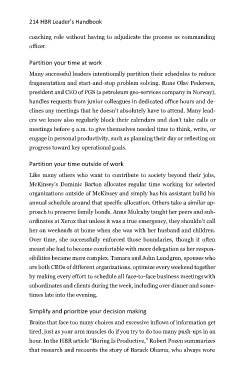Page 225 - HBR Leader's Handbook: Make an Impact, Inspire Your Organization, and Get to the Next Level
P. 225
214 HBR Leader’s Handbook
coaching role without having to adjudicate the process as commanding
officer.
Partition your time at work
Many successful leaders intentionally partition their schedules to reduce
fragmentation and start-and-stop problem solving. Rune Olav Pedersen,
president and CEO of PGS (a petroleum geo-services company in Norway),
handles requests from junior colleagues in dedicated office hours and de-
clines any meetings that he doesn’t absolutely have to attend. Many lead-
ers we know also regularly block their calendars and don’t take calls or
meetings before 9 a.m. to give themselves needed time to think, write, or
engage in personal productivity, such as planning their day or reflecting on
progress toward key operational goals.
Partition your time outside of work
Like many others who want to contribute to society beyond their jobs,
McKinsey’s Dominic Barton allocates regular time working for selected
organizations outside of McKinsey and simply has his assistant build his
annual schedule around that specific allocation. Others take a similar ap-
proach to preserve family bonds. Anne Mulcahy taught her peers and sub-
ordinates at Xerox that unless it was a true emergency, they shouldn’t call
her on weekends at home when she was with her husband and children.
Over time, she successfully enforced those boundaries, though it often
meant she had to become comfortable with more delegation as her respon-
sibilities became more complex. Tamara and John Lundgren, spouses who
are both CEOs of different organizations, optimize every weekend together
by making every effort to schedule all face-to-face business meetings with
subordinates and clients during the week, including over dinner and some-
times late into the evening.
Simplify and prioritize your decision making
Brains that face too many choices and excessive inflows of information get
tired, just as your arm muscles do if you try to do too many push-ups in an
hour. In the HBR article “Boring Is Productive,” Robert Pozen summarizes
that research and recounts the story of Barack Obama, who always wore

